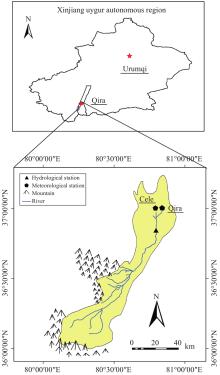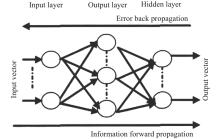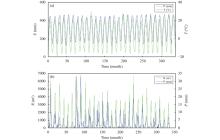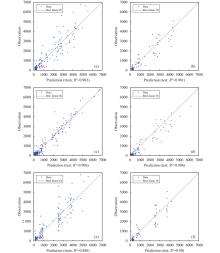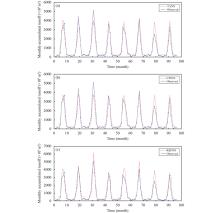Sciences in Cold and Arid Regions ›› 2018, Vol. 10 ›› Issue (6): 468–481.doi: 10.3724/SP.J.1226.2018.00468
Simulation and prediction of monthly accumulated runoff, based on several neural network models under poor data availability
JianPing Qian1,JianPing Zhao1,Yi Liu2,3,XinLong Feng1,DongWei Gui2,3,*( )
)
- 1 College of Mathematics and System Sciences, Xinjiang University, Urumqi, Xinjiang 830046, China
2 State Key Laboratory of Desert and Oasis Ecology, Xinjiang Institute of Ecology and Geography, Chinese Academy of Sciences, Xinjiang 830011, China
3 Cele National Station of Observation and Research for Desert–Grassland Ecosystem, Xinjiang Institute of Ecology and Geography, Chinese Academy of Sciences, Urumqi, Xinjiang 830011, China
| 1 |
Adamowski J, Chan HF A wavelet neural network conjunction model for groundwater level forecasting. Journal of Hydrology 2011; 407: 1–4 28- 40.
doi: 10.1016/j.jhydrol.2011.06.013 |
| 2 | Beale M, Demuth H, 1998. Neural Network Toolbox for Use with MATLAB, User's guide. Works, Natick: The Math, pp. 1–6. |
| 3 |
Boehmer K, Memon A, Mitchell B Towards sustainable water management in Southeast Asia—experiences from Indonesia and Malaysia. Water International 2000; 25: 3 356- 377.
doi: 10.1080/02508060008686843 |
| 4 |
Bowden GJ, Dandy GC, Maierb HR Input determination for neural network models in water resources applications. Part 1- Background and methodology. Journal of Hydrology 2005a; 301: 1–4 75- 92.
doi: 10.1016/j.jhydrol.2004.06.021 |
| 5 |
Bowden GJ, Maierb HR, Dandy GC Input determination for neural network models in water resources applications. Part 2. Case study: Forecasting salinity in a river. Journal of Hydrology 2005b; 301: 1–4 93- 107.
doi: 10.1016/j.jhydrol.2004.06.020 |
| 6 |
Campolo M, Soldati A, Andreussi P Artificial neural network approach to flood forecasting in the River Arno. Hydrological Sciences Journal 2003; 48: 3 381- 398.
doi: 10.1623/hysj.48.3.381.45286 |
| 7 |
Cannas B, Fanni A, See L, et al. Data preprocessing for river flow forecasting using neural networks: wavelet transforms and data partitioning. Physics and Chemistry of the Earth, Parts A/B/C 2006; 31: 18 1164- 1171.
doi: 10.1016/j.pce.2006.03.020 |
| 8 |
Chapman L, Thornes JE The use of geographical information systems in climatology and meteorology. Progress in Physical Geography 2003; 27: 3 313- 330.
doi: 10.1191/030913303767888464 |
| 9 |
Chen XY, Chau KW, Busari AO A comparative study of population-based optimization algorithms for downstream river flow forecasting by a hybrid neural network model. Engineering Applications of Artificial Intelligence 2015; 46: 258- 268.
doi: 10.1016/j.engappai.2015.09.010 |
| 10 |
Chen YN, Xu CC, Hao XM, et al. Fifty-year climate change and its effect on annual runoff in the Tarim River Basin, China. Quaternary International 2009; 208: 1–2 53- 61.
doi: 10.1016/j.quaint.2008.11.011 |
| 11 | Chen YN, 2014. Water Resources Research in Northwest China. Dordrecht: Springer, pp. 1–20. DOI: 10.1007/978-94-017-8017-9. |
| 12 | Dai SY, Lei JQ, Zhao JF, et al. Groundwater characteristics and their effects to eco-environmental of desert-oasis transitional zone in western Qira. Journal of Arid Land Resources and Environment 2009a; 23: 8 99- 103. |
| 13 | Dai SY, Lei JQ, Zhou JF, et al. Changing trend and features of the runoff from mountain areas of the Qira River. Arid Land Geography 2009b; 32: 2 204- 210. |
| 14 |
Dawson CW, Wilby RL Hydrological modelling using artificial neural networks. Progress in Physical Geography 2001; 25: 1 80- 108.
doi: 10.1177/030913330102500104 |
| 15 |
Fang KY, Gou XH, Chen FH, et al. Large-scale precipitation variability over Northwest China inferred from tree rings. Journal of Climate 2011; 24: 13 3457- 3468.
doi: 10.1175/2011JCLI3911.1 |
| 16 |
Grossmann A, Morlet J Decomposition of hardy functions into square integrable wavelets of constant shape. SIAM Journal on Mathematical Analysis 1984; 15: 4 723- 736.
doi: 10.1137/0515056 |
| 17 |
Gupta HV, Sorooshian S, Yapo PO Status of automatic calibration for hydrologic models: comparison with multilevel expert calibration. Journal of Hydrologic Engineering 1999; 4: 2 135- 143.
doi: 10.1061/(ASCE)1084-0699(1999)4:2(135) |
| 18 |
Hagan MT, Menhaj MB Training feedforward networks with the Marquardt algorithm. IEEE Transactions on Neural Networks 1994; 5: 6 989- 993.
doi: 10.1109/72.329697 |
| 19 | Ham FM, Kostanic I, 2000. Principles of Neurocomputing for Science and Engineering. New York: McGraw-Hill Higher Education. |
| 20 |
Hu TS, Lam KC, Ng ST A modified neural network for improving river flow prediction. Hydrological Sciences Journal 2005; 50: 2 318.
doi: 10.1623/hysj.50.2.299.61794 |
| 21 |
Jain SK, Das A, Srivastava DK Application of ANN for reservoir inflow prediction and operation. Journal of Water Resources Planning and Management 1999; 125: 5 263- 271.
doi: 10.1061/(ASCE)0733-9496(1999)125:5(263) |
| 22 |
Jeffrey SJ, Carter JO, Moodie KB, et al. Using spatial interpolation to construct a comprehensive archive of Australian climate data. Environmental Modelling & Software 2001; 16: 4 309- 330.
doi: 10.1016/S1364-8152(01)00008-1 |
| 23 |
Kim CK, Kwak IS, Cha EY et al. Implementation of wavelets and artificial neural networks to detection of toxic response behavior of chironomids (Chironomidae: Diptera) for water quality monitoring. Ecological Modelling 2006; 195: 1–2 61- 71.
doi: 10.1016/j.ecolmodel.2005.11.010 |
| 24 |
Kisi O, Cigizoglu HK Comparison of different ANN techniques in river flow prediction. Civil Engineering and Environmental Systems 2007; 24: 3 211- 231.
doi: 10.1080/10286600600888565 |
| 25 |
Labat D, Ababou R, Mangin A Rainfall-runoff relations for Karstic springs. Part II: continuous wavelet and discrete orthogonal multiresolution analyses. Journal of Hydrology 2000; 238: 3–4 149- 178.
doi: 10.1016/S0022-1694(00)00322-X |
| 26 |
Li XM, Jiang FQ, Li LH, et al. Spatial and temporal variability of precipitation concentration index, concentration degree and concentration period in Xinjiang, China. International Journal of Climatology 2011a; 31: 11 1679- 1693.
doi: 10.1002/joc.2181 |
| 27 |
Li XM, Li LH, Guo LP, et al. Impact of climate factors on runoff in the Kaidu River watershed: path analysis of 50-year data. Journal of Arid Land 2011b; 3: 2 132- 140.
doi: 10.3724/SP.J.1227.2011.00132 |
| 28 |
Li XM, Li LH, Wang XX, et al. Reconstruction of hydrometeorological time series and its uncertainties for the Kaidu River Basin using multiple data sources. Theoretical and Applied Climatology 2013; 113: 1–2 45- 62.
doi: 10.1007/s00704-012-0771-2 |
| 29 |
Licznar P, Nearing MA Artificial neural networks of soil erosion and runoff prediction at the plot scale. CATENA 2003; 51: 2 89- 114.
doi: 10.1016/S0341-8162(02)00147-9 |
| 30 |
Ling HB, Xu HL, Shi W, et al. Regional climate change and its effects on the runoff of Manas River, Xinjiang, China. Environmental Earth Sciences 2011; 64: 8 2203- 2213.
doi: 10.1007/s12665-011-1048-2 |
| 31 | Mallat S, 1998. A wavelet tour of signal processing. New York: Academic. |
| 32 |
Meng LH, Chen YN, Li WH, et al. Fuzzy comprehensive evaluation model for water resources carrying capacity in Tarim River Basin, Xinjiang, China. Chinese Geographical Science 2009; 19: 1 89- 95.
doi: 10.1007/s11769-009-0089-x |
| 33 |
Moody J, Darken C Speedy alternatives to back propagation. Neural Networks 1988; 1: 202- 202.
doi: 10.1016/0893-6080(88)90239-0 |
| 34 |
Moriasi DN, Arnold JG, Van Liew MW, et al. Model evaluation guidelines for systematic quantification of accuracy in watershed simulations. Transactions of the ASABE 2007; 50: 3 885- 900.
doi: 10.13031/2013.23153 |
| 35 |
Nilsson P, Uvo CB, Berndtsson R Monthly runoff simulation: comparing and combining conceptual and neural network models. Journal of Hydrology 2006; 321: 1–4 344- 363.
doi: 10.1016/j.jhydrol.2005.08.007 |
| 36 |
Ninyerola M, Pons X, Roure MJ A methodological approach of climatologically modelling of air temperature and precipitation through GIS techniques. International Journal of Climatology 2000; 20: 14 1823- 1841.
doi: 10.1002/1097-0088(20001130)20:14<1823::AID-JOC566>3.0.CO;2-B |
| 37 |
Nourani V, Alami MT, Aminfar MH A combined neural-wavelet model for prediction of Ligvanchai watershed precipitation. Engineering Applications of Artificial Intelligence 2009a; 22: 3 466- 472.
doi: 10.1016/j.engappai.2008.09.003 |
| 38 |
Nourani V, Komasi M, Mano A A multivariate ANN-wavelet approach for rainfall-runoff modeling. Water Resources Management 2009b; 23: 14 2877- 2894.
doi: 10.1007/s11269-009-9414-5 |
| 39 |
Partal T, Kişi O Wavelet and neuro-fuzzy conjunction model for precipitation forecasting. Journal of Hydrology 2007; 342: 1–2 199- 212.
doi: 10.1016/j.jhydrol.2007.05.026 |
| 40 |
Pramanik N, Panda RK, Singh A Daily river flow forecasting using wavelet ANN hybrid models. Journal of Hydroinformatics 2011; 13: 1 49- 63.
doi: 10.2166/hydro.2010.040 |
| 41 | Salas JD, Markus M, Tokar AS, 2000. Streamflow forecasting based on artificial neural networks. In: Govindaraju RS, Ramachandra Rao A (eds.). Artificial Neural Networks in Hydrology. Dordrecht: Kluwer Academic, 23–51. |
| 42 |
Skirvin SM, Marsh SE, McClaranw MP, et al. Climate spatial variability and data resolution in a semi-arid watershed, south-eastern Arizona. Journal of Arid Environments 2003; 54: 4 667- 686.
doi: 10.1006/jare.2002.1086 |
| 43 |
Srinivasulu S, Jain A A comparative analysis of training methods for artificial neural network rainfall-runoff models. Applied Soft Computing 2006; 6: 3 295- 306.
doi: 10.1016/j.asoc.2005.02.002 |
| 44 |
Sun HW, Gui DW, Yan BW, et al. Assessing the potential of random forest method for estimating solar radiation using air pollution index. Energy Conversion and Management 2016; 119: 121- 129.
doi: 10.1016/j.enconman.2016.04.051 |
| 45 |
Wang W, van Gelder PHAJM, Vrijling JK, et al. Forecasting daily streamflow using hybrid ANN models. Journal of Hydrology 2006; 324: 1–4 383- 399.
doi: 10.1016/j.jhydrol.2005.09.032 |
| 46 |
Wu CL, Chau KW, Li YS Methods to improve neural network performance in daily flows prediction. Journal of Hydrology 2009; 372: 1–4 80- 93.
doi: 10.1016/j.jhydrol.2009.03.038 |
| 47 |
Wu JL, Yang FX, Zhou J, et al. Desert types and characteristics in the Qira River Basin. Arid Land Geography 2013; 36: 5 803- 811.
doi: 10.13826/j.cnki.cn65-1103/x.2013.05.007 |
| 48 |
Wu YW, Yang FX, Hua T Landforms and their effects on ecological pattern in the Qira River Basin. Arid Zone Research 2011; 28: 2 355- 362.
doi: 10.13866/j.azr.2011.02.019 |
| 49 |
Wu ZT, Zhang HJ, Krause CM, et al. Climate change and human activities: a case study in Xinjiang, China. Climate Chang 2010; 99: 3–4 457- 472.
doi: 10.1007/s10584-009-9760-6 |
| 50 |
Xue J, Gui DW, Zhao Y, et al. Quantification of environmental flow requirements to support ecosystem services of Oasis Areas: a case study in Tarim Basin, Northwest China. Water 2015; 7: 10 5657- 5675.
doi: 10.3390/w7105657 |
| 51 |
Xue J, Gui DW, Lei JQ, et al. Reconstructing meteorological time series to quantify the uncertainties of runoff simulation in the Ungauged Qira River basin using data from multiple stations. Theoretical and Applied Climatology 2016; 126: 1–2 61- 76.
doi: 10.1007/s00704-015-1548-1 |
| 52 |
Xue J, Gui DW, Lei JQ, et al. Model development of a participatory Bayesian network for coupling ecosystem services into integrated water resources management. Journal of Hydrology 2017a; 554: 50- 65.
doi: 10.1016/j.jhydrol.2017.08.045 |
| 53 |
Xue J, Gui DW, Lei JQ, et al. A hybrid Bayesian network approach for trade-offs between environmental flows and agricultural water using dynamic discretization. Advances in Water Resources 2017b; 110: 445- 458.
doi: 10.1016/j.advwatres.2016.10.022 |
| 54 |
Zhang B, Govindaraju RS Prediction of watershed runoff using bayesian concepts and modular neural networks. Water Resources Research 2000; 36: 3 753- 762.
doi: 10.1029/1999WR900264 |
| No related articles found! |

